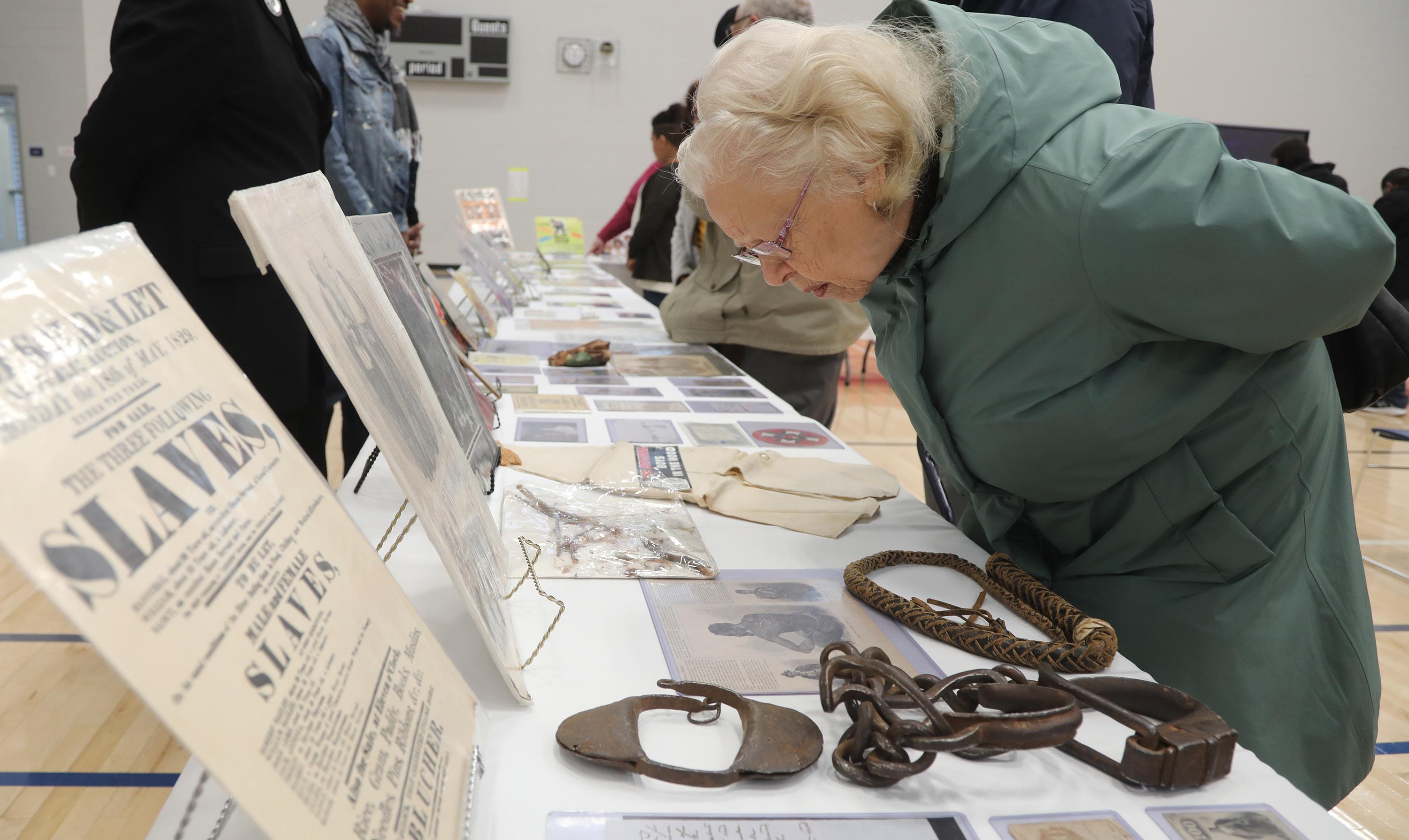
5 minute read
Oberlin Elementary hosts Black History museum
OBERLIN — It’s taken Khalid el-Hakim more than 30 years to collect artifacts spanning the past 400.
From shackles and chains and Klu Klux Klan patches to N.W.A. CDs and Black Lives Matter movement T-shirts, elHakim’s Black History 101 Mobile Museum started as an effort to supplement his social studies classes in Detroit Public Schools.
“I used to collect and use artifacts in my classroom to engage my students, simply because of the lack of Black history in the textbooks and in the curriculum,” he said. “So I found myself supplementing what was missing with primary source material.”
From there, the collection grew, through flea markets, and thrift and antiques stores. Stereotypical advertising images were created by white imaginations, and mass-produced to be used by white people, he said.
As older people died, those boxes of toothpaste, syrup, advertisements and other items found their way to shops for el-Hakim to find in his own travels, both in building the museum and as a hip-hop manager and booking agent.
When the project started 30 years ago, some of the things may have been disturbing — but el-Hakim is no longer surprised by what he sees, he said.
The project started tour- ing in 2006 and has since traveled to 42 different states and more than 1,000 institutions.
On Monday, a portion of el-Hakim’s collection visited Oberlin Elementary, after retired orchestra teacher Harriett Thomas and the fund established for her late husband, J.B. Thomas, through the Lorain County Community Foundation sought out the exhibit.

“Even when I was in the Oberlin Schools I was able to do different projects … so I’ve been gone for the past eight years,” she said. “It’s time to come back and try to do something. So I thought, well, let’s start with a Black history proj-
Letters
• Signed. Include your name, address, and daytime telephone number for our records. Up to two signatures.
• The deadline to submit letters is 10 a.m. each Monday. They are used on a space-available basis. We reserve the right to edit any submission for length, grammar, spelling, and clarity, or to reject any submission.
ect. And I saw the mobile museum and got in touch with Khalid el-Hakim.”
Thomas, who worked for Oberlin Schools for 39 years, started the effort in August. And on Monday, she watched as students from Oberlin Schools walked past the tables, commenting on the items cataloged there.
Her husband was always involved with youth in Oberlin, she said — be it the athletes he coached, the students he tutored or the orchestra trips he chaperoned with his wife, Thomas said.
She plans to bring different projects to Oberlin Schools each year, in her husband’s name — and the mobile museum made perfect sense for her first undertaking.
This year’s mobile history exhibit marks the 50th anniversary of hip-hop culture. While the first two tables of the exhibit are some of the oldest items, some dating back to the trans-Atlantic slave trade, the second half looked at the roots of hip-hop, not just as a musical genre, but tied to the social movements, el-Hakim said.
“That whole experience in Detroit shaped my worldview — from Motown to techno music, Martin Luther King first giving the ‘I Have a Dream’ speech there and Malcolm X’s roots being there … all of that helped shape who I am and how I look at this work as well,” he said.
Material from the anti-apartheid movement, 1980s Stop the Violence movement, 1995’s Million Man March, Barack Obama’s first presidential campaign, and the current Black Lives Matter movement are all highlighted.
The latter half of the exhibit was also a chance to carry forward the work of el-Hakim’s friend and former client, rapper Proof, who was in Detroit’s D12 and other groups with Eminem. He was shot and killed in 2006.
“I want people to walk away with a sense of being inspired, empowered and motivated to go do more research about aspects of Black history that they have not been exposed to before,” he said.
Oberlin’s Wilson Bruce Evans Home Historical Society received $18,000 for handicapped-accessible restrooms in a recent, historically appropriate addition to the rear of the home. Cabinetmaker Wilson Bruce Evans was a Black abolitionist and Underground Railroad operative from Oberlin. His home, finished in 1856, has been a National Historic Landmark since 1997 and is now a museum.
Wellington
The Southern Lorain County Historical Society received $17,419 for its
Radio
FROM A1 the main issue at hand” or simply disagree with the decision.


“In a few short months, I think this will all be resolved and it will no longer be news,” he said.
The deputies union, Lorain County fire chiefs and their supporters have alleged that the vote to rescind the contract was an underhanded attempt to favor the state-run MultiAgency Radio Communication System or MARCS.
Motorola had asked the county for more time to put in a bid on behalf of MARCS, but in the end, did not submit a bid for consideration. MARCS is used by the State Highway Patrol and by agencies in a majority of Ohio counties.
Fire chiefs, deputies and Stammitti said the quality of the L3 Harris system is clear and it’s the one they want, while MARCS radios might require millions of dollars in expensive equipment to be installed to work properly.
Wellington Fire Chief
Mike Wetherbee is among those who favor the L3 Harris radios and is critical of MARCS’ abilities in his communities.
The Lorain County AFL-CIO also backs the L3 Harris system, which is already in use by fire departments in Avon, Avon Lake, Sheffield, Sheffield Lake and North Ridgeville
Willard Initiative Phase 2, a continuing project to preserve a large Masonicthemed mural painted by Archibald Willard, of Wellington, in the 1870s. The mural is 11-by-13 feet and its conservation started in 2019. The grant will allow the historical society to hire professional conservators to restore a second mural that, once completed, will be on display at the Spirit of ‘76 Museum in Wellington.
Lorain to great effect, officials in the majority of those cities have said.
The Lorain Historical Society received $5,000 for shelving for its textile collection at the Moore House Museum. The society’s textile collection is stored in the 1906 home and overburdened the stationary shelving, in turn undermining the floor joints that support it, according to an Ohio History Fund news release. The grant will help Lorain Historical purchase new, movable shelving and pay the salary of an intern to assemble it and rehome the textile collection.
Mayors and fire chiefs in Elyria and Lorain also publicly backed the L3 Harris systems in their cities.
Schneider wrote that the decision to revoke the contract “and attempt to steer the project toward an antiquated state-owned system preferred by those who have zero interest or investment in the people of this village, the surrounding communities and Lorain County, in general, was not” open, thoughtful, researched and honest as the bid process was.
“It’s politics at its worst — deceitful, uncaring, cold and dishonest,” he wrote. Schneider said Wellington “will be making sure our voice is heard on this issue and that the county commissioners erred when they put backroom politics over public safety.”
He invited village residents and those in Brighton, Huntington, Penfield, Pittsfield and Wellington townships served by the Wellington Community Fire District to contact the board of commissioners directly, drop a letter off at Wellington Town Hall at 115 Willard Memorial Square, or to email him a letter at hschneider@ villageofwellington.com so it can be delivered to county officials.










